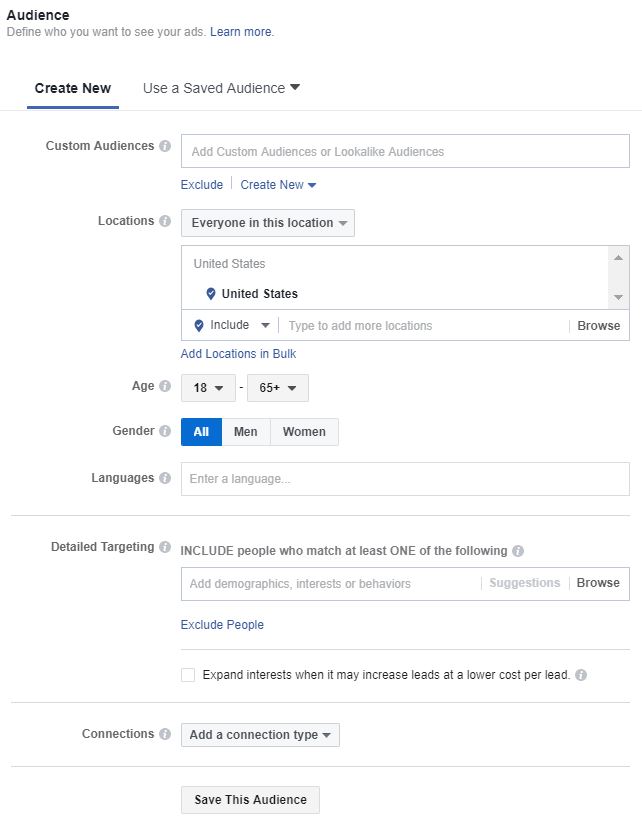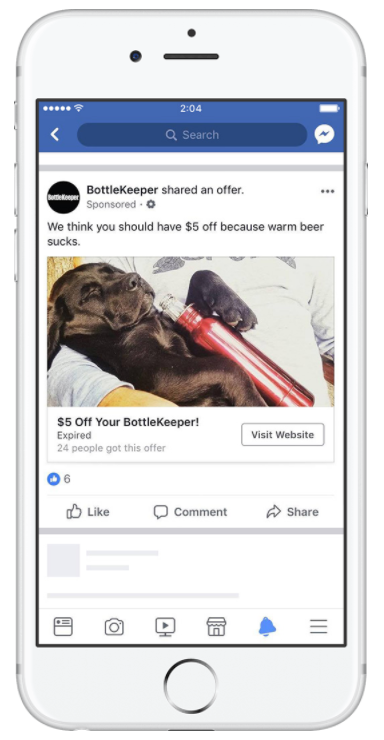When it comes to Facebook advertising, the hype is real.
The numbers don’t lie in regard to Facebook’s marketing firepower. With 93% of marketers already on board, the platform’s diverse and laser-targeted ad platform is paying dividends for those with a mapped-out Facebook advertising strategy.
Whether you’re curious about the buzz surrounding Facebook ads or are looking to fine-tune your current social media advertising campaigns, 2018 is poised to be a major milestone for the world’s largest social network.
That said, succeeding with Facebook advertising isn’t as easy as flipping a switch. From targeting specific users to finding the right ad format, there are tons of variables that can make or break your campaigns.
That’s why we’ve outlined the essential steps to an optimized Facebook advertising strategy in 2018. This guide will not only cover best practices for how to poise your campaigns for more clicks, but also how to avoid some of the most common pitfalls for Facebook ads.
Here are four tips to optimize your Facebook advertising strategy:
1. Choose the Right Target Audience
Let’s start with a reality check. Your Facebook ads are only as effective as how well you can define your audience.

And sure, you probably think that you know your target audience pretty well, right? Their wants, desires, pain points and what makes them tick.
But harnessing the power of Facebook’s ad platform comes down to your audience’s demographics. Data points such as age, location, job roles and interests are paramount to making sure you’re reaching the right prospects.
For example, according to one of Facebook’s own client case studies, ad targeting resulted in 3 times higher ROI alongside a respective CTR and significantly lower cost-per-action. Those numbers are nothing to scoff at.
How to Define an Audience on Facebook
Think of defining your audience as square one. How you define your audience ultimately lays the groundwork for how your ad will perform.
Thankfully, Facebook helps brands see how broad or narrow their targeting is and what they can do to improve their ad performance. When creating a Facebook ad, regardless of ad type or goals, marketers have the opportunity to fill in their audience’s details based on who you’re trying to reach.

The more you drill down your details, the more likely your ad is to resonate with users. Whether you’re trying to find marketers in Chicago or foodies in Los Angeles, you ultimately decide who’s going to potentially see your ad.
Facebook provides their own barometer to let you know whether your audience might be too broad or specific.

2. Test Different Facebook Ad Types
What separates Facebook from other ad platforms is its variety. The freedom brands have in terms of customization provides seemingly endless possibilities for creative, compelling ads.
Additionally, just about any given goal for your Facebook advertising strategy is fair game.
- Looking to drive app downloads? Check.
- Need to show off products and offers? Check.
- Want to advertise your latest webinar or case study? Check.
And that doesn’t even scratch the surface of what’s possible via Facebook advertising. Below are five of the most popular types of Facebook ads for brands:
Carousel Ads
Facebook carousel ads are noted to boast a lower cost-per-conversion and cost-per-click compared to static ads. Interactive and mobile-friendly, creative marketers love to use carousels to show off products and tell stories.

Offers & Homepage Ads
Even with all of Facebook’s functionalities, brands always have the option of keeping their ads simple.
Want to include a discount or promo code? No problem. Traditional Facebook ads such as this one from BottleKeeper can funnel traffic from the social network back to your site. These sorts of ads are great for retargeting, reminding people who’ve visited your site to engage with you again.

Video Ads
Video content marketing is booming, especially on Facebook where users spend triple the time interacting with video as opposed to text or image-based content.
You can think of a video ad as a sort of mini commercial for your brand. Videos are a great way to stop scrollers in their tracks to see what your ad is about. Meanwhile, you also have the opportunity to tell your ad’s story without requiring users to leave Facebook.
Brands such as SakeTrek have noted exponentially higher downloads and in-app purchases after running ads to promote their free trial via video.

Boosted & Promoted Posts
Perhaps one of the easiest ways to run an ad is by simply promoting your existing Facebook content.
If you have a high-performing piece of content or product launch that you want to share with the world, you can essentially boost it in an instant to gain exposure to a new audience. Promoted posts are a cost-effective, near-instant approach to getting more eyes on your brand as you show up in the feeds of new potential followers.

Lead Ads
Akin to a traditional lead magnet, lead ads allow users to download content from your brand directly from Facebook. Ideal for brands promoting webinars or downloadable PDF’s, these types of ads serve as a reminder of Facebook’s potential as a list-building tool. If you have a piece of educational content that your audience is hungry for, lead ads are the way to go.

Each of these types of ads serves a particular purpose, meaning that most brands don’t typically stick to “one” type of ad. Over time, you can figure out which types of promotions are your go-to’s as part of your Facebook advertising strategy and tweak them over time.
A Better Way to Manage Social
A Better Way to Manage Social
3. Tap Into the Power of Facebook Remarketing
If you’re on the fence about your audience or what type of ad to use, don’t panic. The process of setting up a campaign can be daunting as you wonder whether or not your hard work will pay off.
As a result, you might want to consider honing your Facebook advertising strategy on your existing leads. Through remarketing, Facebook allows you to serve ads to a custom audience of people who’ve interacted with your brand before based on a Custom Audience. These interactions might include:
- People who have previously visited your website
- People who have made a purchase on your site in the past
- People on your email list

These people represent your hottest leads who already know your brand and what you’re all about. This makes it easier to give them that extra little “push.” Brands with significant traffic and sizable email lists may want to start with remarketing first versus creating their own audience. You can read more in our quick guide to Facebook remarketing.
What About Lookalike Audiences?
Those who’ve run ads in the past can squeeze more out of future ads through Lookalike Audiences. This feature essentially creates a new audience based on your previous ad data, tapping into a new set of targets that are similar to your own audience.
Think of Lookalike Audiences as a sort of shortcut. If you’ve already run ads and have targeted previous customers in the past, a Lookalike audience can introduce you to totally new users who are likely to engage with your content.
4. Running Budget-Friendly Facebook Advertising Strategy
Facebook ads are lauded for their impressive CPC and ability for brands to define their own budgets.
But poorly targeted campaigns that are left unchecked can quickly get pricey. Facebook advertising cost varies depending on your industry and size of your audience, as well as the timing and optimization of your ads.
Facebook allows you to set your budget on either a daily or “lifetime” basis. On a daily budget, Facebook determines the best opportunities to serve your ad based on an average over the course of time. Facebook may exceed your budget by 25% if they deem necessary based on the opportunities available.

On the flip side, you can set a flat fee budget (aka “lifetime” budget) where Facebook will spend as much or as little of your budget as they see necessary over time. In some cases, Facebook notes that a budget of hundreds of dollars could be gone in a mere day based on the opportunities observed by their algorithm.
There is no “right” way to budget, but those experimenting with ads for the first time may want to opt for a smaller budget to test the waters.
Testing Your Ads
Speaking of tests, never dump money into a campaign without running a test ad first. Facebook makes this easy with a built-in split testing system to outline which types of ads have the most potential to perform. In short, you create variations of your ad to pinpoint which one is the best on paper.

But what elements of your Facebook ads should you test, anyway? Some options might include:
- Ad types
- Images
- Ad Copy
- Calls-to-action
- Audiences
- Offers, incentives and lead magnets
Again, there are a lot of variables at play here.
It’s easy to get caught up with analysis paralysis with your Facebook advertising strategy, but that’s exactly what tests are for. If you have other PPC or email marketing campaigns that have performed well, start by using those pieces in your Facebook advertising strategy.
What Are Your Facebook Ad Goals for 2018?
There is no one-size-fits-all Facebook marketing strategy out there, especially given how granular and diverse the platform’s ads can be.
Even so, marketers of all walks of life should pay especially close attention to their audiences, ad types and how they test their ads. Facebook ads represent a goldmine for marketers who have their strategies ironed out instead of flying blindly.
So, what are you looking to accomplish with Facebook Ads in 2018? Any pieces of the platform that you find difficult to get “just right?” Let us know in the comments below!
